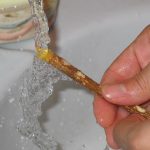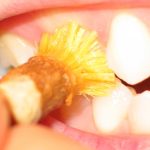Preparation and Use of Miswak

The outer bark is removed from one end of the miswak (a traditional teeth-cleaning stick) to a length of about one centimeter in a circular manner, while the other end is sharpened to create a fine, pointed tip suitable for use as a toothpick to remove food particles stuck between the teeth. The end from which the bark has been removed is placed between the upper and lower molars and chewed slightly until the fibers under the bark are exposed. These fibers contain beneficial substances for the oral tissues and teeth.

Once the fibers, which resemble a brush, have been exposed, they should be rinsed with a little water to remove any debris from the mouth. Finally, the miswak is placed in a clean cover specifically designed for it.
Guidelines for Using Miswak:
– It’s advisable to stand in front of a mirror when starting to clean your teeth to see them clearly.
– Rinse your mouth to remove deposits and residues.
– Mentally divide the teeth into four sections: upper right, upper left, lower right, and lower left.
– Hold the miswak in the way that feels most comfortable for you. Some people prefer to grip it with their fingers and the palm of their hand, while others prefer to hold it like a pen.
– It is recommended to wash the tip of the miswak intended for use with a little running water from the tap to remove any dirt that may be stuck between the fibers.
– When using the miswak to clean the upper teeth, it’s advised to place part of the fibers at the gum line where it meets the tooth, and move the miswak downward with moderate pressure so that the head of the miswak forms a right or acute angle with the axis of the tooth. The movement should be outward, downward, not against the gum, to avoid injuring it and to clean the critical area where deposits and residues tend to accumulate—the necks of the teeth.
– Focus on each tooth individually, especially around the neck and surface, and clean each of the imaginary sections separately.
– When using the miswak to clean the lower teeth, the movements should be from bottom to top, which is the opposite of what is done for cleaning the upper teeth.
– It is advisable to keep the miswak in the mouth for a short period after cleaning the teeth and chew it a few times from time to time. This practice helps increase saliva production, which aids in cleaning the teeth, neutralizing acidity in the mouth, combating harmful oral bacteria, and assisting digestion, in addition to the beneficial astringent substances naturally present in the miswak for oral tissues and teeth.
– After use, the tip of the miswak should be cleaned and placed back in its specific cover.
– The ends of the miswak should be trimmed once every two days to ensure clean and effective bristles.







